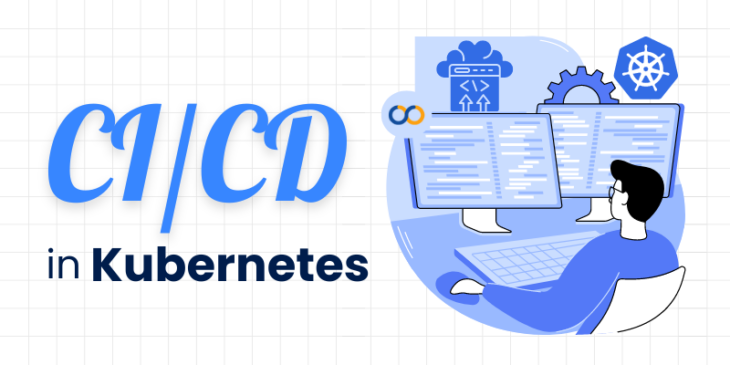
Continuous Integration and Continuous Deployment is a process of delivering applications to customers by introducing automation into the different stages of the development cycle. Right from integration and testing phases to delivery and deployment, CI/CD in DevOps brings in automation and continuous monitoring throughout the application lifecycle.
The CI/CD methodology addresses all problems that integration of a new code can cause for the DevOps teams. These practices for the “CI/CD pipeline”, are looked after by the development & SRE teams to streamline the development process. Here, in this blog, we’ll dive into some of the best practices for continuous delivery in Kubernetes.
Challenges faced during CI/CD
Here are some of the challenges that DevOps teams have to face during the Continuous Deployment and Continuous Integration approach. Let’s take a look!
Adapting to the DevOps Model & Prioritizing Automation
Shifting from the waterfall model to the DevOps model isn’t an easy objective to achieve. The process requires a meticulous study of the critical DevOps priorities considering which process within the CI/CD deployment needs to be automated first. After looking into the priorities, DevOps teams can start executing the CI/CD best practices.
Once the priorities for the implementation of CI/CD in DevOps are finalized, the IT & SRE teams need to compile and integrate the code. This is where automation is required as the process can be prone to errors if done manually. Though automation yields great results, it is not essential to automate everything at once. By breaking processes into segments and automating them, things can be made easier and faster.
Security Mishaps
Security is an important aspect that needs to be taken care of for leveraging CI/CD benefits. Integrating security into DevSecOps pipelines is quite a challenging and complex task. Security testing consumes a lot of time which slows down the DevOps process. Moreover, security tools consist of an individual dashboard making it difficult for the interfaces to integrate and creating problems in integration. With the help of the right CI/CD pipeline tools and focused CI/CD deployment & monitoring practices, SRE & IT teams can easily eradicate security and non-compliance issues existing in the different stages of the DevOps lifecycle.
Mistaking Continuous Deployment for Continuous Delivery
Continuous deployment is a process to deploy code into production through automation testing while continuous delivery prepares the DevOps teams for delivery to production. DevOps and SRE teams mistakenly consider continuous deployment for continuous delivery and tend to mishandle the DevSecOps pipelines. Continuous delivery helps in controlling the functionality and rolling out of the product while deployment involves deploying the product into production after updates have been made.
CI//CD Best Practices
Every business organization tries to find the perfect practices while setting up its DevSecOps pipelines. Let’s read some basic principles for the effective and secure CI/CD pipeline and how BuildPiper– The most powerful Internal DevSecOps Platform can help enterprises and DevOps teams with a hassle-free and quick setup of delivery pipelines.
Fail Faster and Cheaper
Automating the entire build process is the basic idea behind setting up a CI pipeline. The build process should involve the process of version control and issue tracking. The CI pipeline should integrate and run unit tests so that the builds fail for the codes that do not meet the products’ functional requirements. This prevents huge losses by detecting bugs and issues in the advanced stages of the pipeline.
A common pitfall observed during the CI process is that of not having enough unit tests or code coverage which can lead to builds that pass a CI pipeline but fail further into the software delivery process resulting in delayed product release.
Fix The Broken Build
The second practice involves fixing the broken builds. Continuous integration runs on the assumption that software development teams are working on known stable versions of the code. But what if the code that is being integrated and tested in the pipeline is erroneous? So to keep the application code stable & well-tested and enable a quick & hassle-free delivery, it’s important to ensure that the build and test process is visible and well-monitored by the IT teams.
An ideal CI pipeline checks all versions of code against failures and tracks the corresponding code changes. Building DevSecOps pipelines to control quality assurance (QA) or to provide testing environments can be really beneficial for software development and QA teams looking to deliver products with quality and speed.
Continuously Automate the Software Delivery Lifecycle
IT organizations dealing with technical services have a process of developing and deploying code. This release and deployment process may change over time due to avant-garde technologies and processes popping up in the market. With time, technologies may become obsolete and outdated which is why it is important to be well-acquainted with the CI/CD deployment practices being used.
Also, it’s important to continually evaluate and analyze which processes and tests need to be integrated or automated into the DevSecOps pipeline to allow businesses to leverage the CI/CD benefits. An ideal CI/CD pipeline must include provisioning infrastructure and features that can enable faster deployment of applications, continuous CI checks, quality assurance/testing and monitoring.
Final Wrap-up
There is no one-size-fits-all solution for all pipelines that can go with multiple deployment scenarios. Different pipelines support different kinds of deployments based on the architectural design. Choosing CI/CD pipeline tools and practices that righty fit with the development approaches being implemented should be a high-priority task for IT teams.



